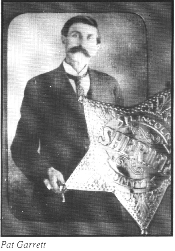|
|
|
 It was Leap Year Day. Mid-morning
Saturday February 29, 1908, was the
appointed time for 57-year-old Pat
Garrett to meet his fate at a mesquite-covered desert crossroads called Alameda
Arroyo on the desolate Mail Road a few
miles east of Las Cruces, county seat of
Dona Ana County, New Mexico. A
chunk of lead slamrned into the back of
Pat Garrett's head pushing some of his
graying brown hair into his skull. The
aging bounty hunter was knocked
forward, hit the ground and rolled over
on his back as a second piece of hot lead
bored into the front of his body.
It was Leap Year Day. Mid-morning
Saturday February 29, 1908, was the
appointed time for 57-year-old Pat
Garrett to meet his fate at a mesquite-covered desert crossroads called Alameda
Arroyo on the desolate Mail Road a few
miles east of Las Cruces, county seat of
Dona Ana County, New Mexico. A
chunk of lead slamrned into the back of
Pat Garrett's head pushing some of his
graying brown hair into his skull. The
aging bounty hunter was knocked
forward, hit the ground and rolled over
on his back as a second piece of hot lead
bored into the front of his body.